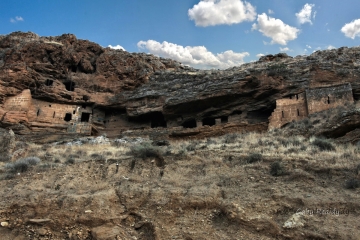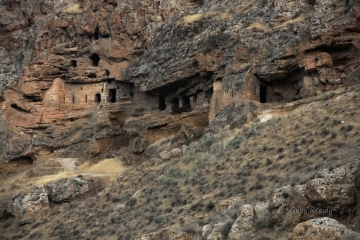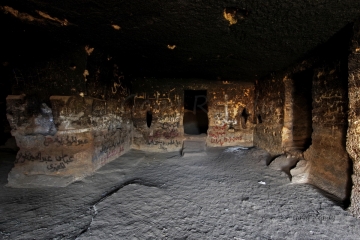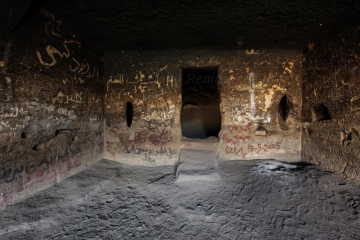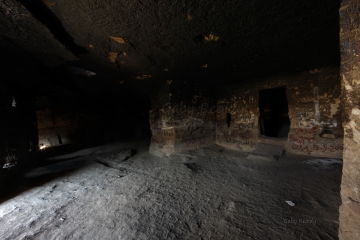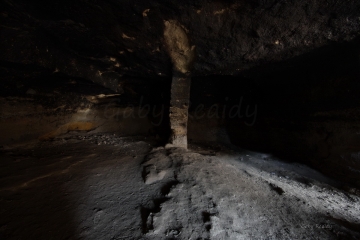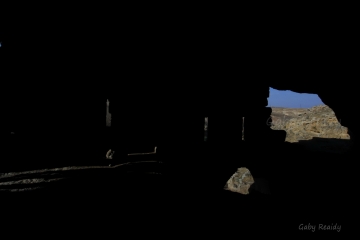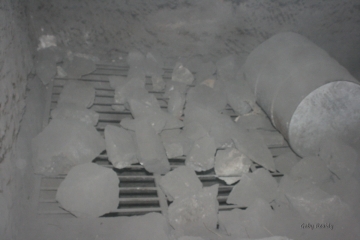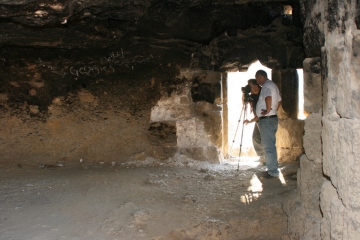مغارة الراهب - الهرمل
إن هذه اللَمحَة التاريخية عن مغارة الراهب، لا تَتَناول المَراكِز البطريركية المارونية الدائمة والعابرة على مدى التاريخ، إنما بصورة استثنائية، كان لا بُدَّ أن تُذكر، كونها كانت مُنطلقاً لإنتشار المارونية في لبنان عن طريق رُهبانه.. مع غيرهم من المُبشّرين الذين وفدوا إلى لبنان لاجئين إليه من شمال سوريا على أثر الاضطهادات التي لَحِقتهم هناك، فكان هذا الإنتشار للطائفة في لبنان مُمَهِداً لإنشاء بطريركية لها، تنقّلت ما بين عِدَة أديار، إكتسبت من جرّاء ذلك صِفَة الأديار البطريركية.
هذا الموقع هو "مغارة الراهب"، القائمة بجوار منبع نهر العاصي في منطقة الهرمل (وكلمة "الهرمل" تعني "طيب الله" او "حمى الله")، والتي لم تَكُن لها في البدء، في العِرف العام، أية صفة دينية، بل كانت تُعتَبر مغارة طبيعية كسائر المغاور في لبنان التي تكوَّنت بفعل عوامل الطبيعة ولا أثر فيها ليد الإنسان. ولكنَّ اسَماً آخر كانت تتداوله الالسنة هو "قصر البُناة" لَفَت مع الاسم الأول انتباه الباحثين بِحَيث دَفَعاهم إلى تَقَصّي مَنشأهما ولماذا أُطلق هذا الاسم على هذه المغارة. فتبيَن من بعض المصادر التاريخية أن المقصود بالبُناة هم المُهندسون والمِعماريون الرومان الذين كانوا يعمَلون في ذلك المِكان لحفَر قنوات من أجل جرّ مياه النهر إلى مملكة تدمر وبناء قاموع الهرمل ، فحفروا الصخر هناك على ثلاثة مُستويات ليستريحوا داخله بعد إنتهائهم من العمل، وذلك نحو سنة 200 قبل الميلاد.
أما اسم مغارة الراهب فلكونها استُعملت في القرن السادس من جانب نُسّاك ورهبان موارنة هربوا من ديرهم في سوريا بعد أن قُتل منهم حوالي 350 راهباَ وتبعثرت محتويات ديرهم. فأجروا توسيعاً لها وأصبحت ديراً للصلاة والعبادة، وهذا ما ألقى الضوء على العلاقة التاريخية، التي كانت مَجهولة، ما بين هذا الأثر وأوائل عهد الطائفة المارونية.
تَرتَفِع المغارة حوالى مئة متر عن الضفة الشرقية لنهر العاصي، وهي بِمُحاذاة نبع عين الزرقاء حيث ينبع العاصي، وتُشرف على مُنحدر شديد ينتهي في أسفل الوادي. أضيفت إلى المغارة، التي يُحصّنها موقعها الطبيعي، عدَّة غُرف تتدرَّج على ثلاث طبقات ذات جُدران مَبنيّة من الطين، ولها نوافذ وقماريات.
هذه المعلومات كانت مثاراً لكلام كثير قيل حول هذا المقرّ الذي تحوَّل مركزاً دينياً مسيحياً، لأن كل المعالم الوثنية التي كانت قائمة قبل انتشار الدين المسيحيّ في تلك الأرجاء قد تحوَّلت مسيحيةً وأقام فيها المسيحيون. وهكذا فإن المسيحيين، بعد الرومان، هم الذين أقاموا في هذه المغارة – القلعة وحوَّلوها ديراً، وقد ظلّت في يد المسيحيين طوال القرون الوسطى. ولَعَلَّ ذلك إستمرَّ من حين أن شغلها تلامذة مار مارون، ولا نَعرِف بَعد ذلك كيف أصبحت مُلكاً لإحدى عشائر المنطقة كما تُفيد بذلك السِجِلاّت العقارية. ولكنَّ، لأسبابٍ سياسيةٍ وأمنيَّة بعد قيام الانتداب الفرنسيّ على سوريا ولبنان، نَزَحَت العشيرة المذكورة من تلك المنطقة إلى داخل سوريا، وعندها سَلَّمَت سُلُطات الإنتداب موقع المغارة إلى المراجع الدينية.. حَيثُ كانت قد أُنشئت مطرانية مارونية باسم "أبرشية بعلبك"، فأصبحت المغارة ومُحيطها في عِهدتها. وظلَّ الأمر كذلك حتى العام 1934، إذ كانت العشيرة المالكة الأراضي عقارياً كما ذكرنا قد عادت إلى موطنها، فأقامت احدى نسائها دعوى قضائية لاسترداد هذه الأراضي، فبقيت هذه الدعوى متأرجحةً في القضاء مدة 23 سنة حتى العام 1957 حين صدرالحُكم فيها لصالح العشيرة.
وحدث، بعد أن رَسَت مُلكية هذه الأراضي حيث موقع المغارة للعشيرة المذكورة، انتقلت مُلكيتها إلى إحدى الشخصيات المارونية المتنية، وكان الدافع إلى هذا الانتقال، كما قال وريث المالك الجديد من بعده، هو صيانة هذا الموقع، والابقاء على طابعه المارونيّ. ولكنَّ دواعيَ أخرى، بيئية ، أوجبت إستملاك الدولة لهذه الأراضي من أجل إقامة سدّ تحويلي على نهر العاصي لحِماية مياهه من التلوُّث، إذ كان والمغارة مَسرَحاً للرعاة ومواشيهم وعِرضةً لجميع أنواع العبث ورمي النفايات والمُخلَّفات، مع ما يُضيفه على ذلك زوّار هذه المناطق والمارّون فيها مِمّا ينافي قواعِد النظافة وسلامة البيئة ويُشكّل ضرراً على الصحة وعلى المزروعات.
فكان الاستملاك مَوضِع مُراجعات من ورثة المالك لإسترجاعها، ومَوضِع مراجعات، في الوقت نفسه، من أبرشية بعلبك المارونية لاسترجاع موقع المغارة بصفتها ذات وضعٍ خاص جداً يوجب الحفاظ على وجهها الدينيّ وعدم شمولها بهذا الإستملاك.هذه المساعي كانت مَحَطّ اهتمام المطارنة الذين تعاقبوا على أبرشيّة بعلبك للموارنة منذ أن وَضَعت الدولة يدها عليها، وإنّما حالت موانع قانونية دون استرداد مِلكية العقار من الدولة، لكون الدولة لا تستطيع مراعاة إعتبارات لاعلاقة لها بمسؤوليتها.. والتنازل لهذا الغرض عن أجزاء مما استملكته من أجل المصلحة العامة. غير ان الدولة أبدت تفهُّماً للوضع الخاص الذي لهذه المغارة، والذي يوجب استثناءها من جميع الاعتبارات والدواعي، فتكلَّلت هذه المساعي بالنجاح بعد جهود جاهدة، إنما عن طريق التوصل إلى حلٍّ هو اشغال الأبرشية للعقار الذي تقع فيه المغارة على سبيل الإيجار، وذلك ببدل إيجار سنويٍّ رمزيّ، لتظل محافظةً على هويتها الأصلية كمزارٍ مقدَّس، وصَرح من الصُروح العريقة التي تُفاخر بها الطائفة المارونية. أمّا في العام 2014 فقد تَمَّت مُقايضة عقارية بين الدولة اللبنانية وأبرشية بعلبك المارونية تَمَّت بِموجَبها إعادة مُلكية المغارة وجوارها إلى هذه الأبرشية وذلك في إطار مرسومٍ شرعيٍ.
وقد تكرَّس حق الطائفة المارونية بهذا الرمز التاريخيّ، وبأن هذا الحق يسمو على المقتضيات الدنيوية، بالزيارة التي قام بها اليه غبطة البطريرك مار بشارة بطرس الراعي في الثامن عشر من ايلول عام 2011، إذ لو لم يكن هذا المقام ذا دلالةٍ خاصة وعلاقة حميمة بالطائفة المارونية تعود إلى عهد مُمعِن في القِدَم ومُمتَد إلى أغوار التاريخ المارونيّ لما كان غبطته قد خصَّه بهذه الالتفاتة التي توَّجت الجهود والمساعي التي أدَّت إلى استرداده للطائفة عملياً وواقعياً ولو أنه لم يُسجَّل على الصحيفة العقارية باسم مرجع من مراجعها، إذ أنه أول بطريرك ماروني يزور تلك المنطقة التي لم تطأها من قبل قدم ايّ سلفٍ من أسلافه.
وبمناسبة عيد مار مارون 2019 أقيم قداس إلهي داخل المغارة ، وذلك لأول مرة منذ أكثر من ألف عام، ترأسه أمين السر العام للرهبانية اللبنانية المارونية الأب ميشال ابو طقة، في حضور رجال دين وفاعليات البقاع الشمالي. واعتبر أبو طقة ان "القداس اليوم هو نقطة للتلاقي بين سائر الديانات السماوية ولترسيخ القيم الإلهية"، منوها "بإحتضان أهل المنطقة بِمُختلف دياناتهم لهذا الدير المُقَدَّس". يُشار إلى ان المغارة شهدت مؤخراً عمليات ترميم وتأهيل واستقبلت المئات من اللبنانيين الذي قدموا اليه من مختلف المناطق.
The Monk’s Grotto – Al Hermel
We do not mention in this historical overview the many permanent and temporary Maronite Patriarchal headquarters throughout history. It is, however, essential to speak of the Monk’s Grotto, which was the starting point of the spread of Maronites in Lebanon, through the efforts of Maronite monks and other missionaries from northern Syria who escaped prosecution by taking refuge in Lebanon. The Maronite community’s spread paved the way to the establishment of its Patriarchate, and its many hosting monasteries became consequently Patriarchal headquarters.
“The Monk’s Grotto”, which is located nearby the source of the Orontes River in the Hermel region (the meaning of “Hermel” being “Divine Protection”), was not initially considered to be of any religious significance but was rather deemed a natural grotto similar to many others in Lebanon, formed by nature and devoid of any human trace. However, this grotto also went by the name of “Qasr al-Bounat” (the Builders’ Castle), which intrigued researchers who found out that the “builders” were the roman architects and construction workers who dug channels to draw the river’s waters to the Kingdom of Palmyra, and who built the Hermel Pyramid; they had also chiseled the surrounding rocks on three different levels into a rest area, in around 200 BC.
The grotto also acquired its name of “Monks’ Grotto” in the 6th century, when it became a refuge for hermits and Maronite monks who had fled Syria after around 350 of their own were massacred and the content of their monastery was scattered. After being expanded, the grotto became a monastery and a sanctuary for prayer and adoration. This transformation, indeed, formed the historical link between the grotto and the beginning of the Maronite community’s era.
The grotto rises about a hundred meters from the eastern bank of the Orontes River. It is adjacent to the Ain al-Zarqa water source, from which the river springs, and overlooks a steep slope that ends at the bottom of the valley. The grotto is naturally fortified by its location, and numerous rooms were added and arranged in three layers, with walls built of mud and several rows of windows.
Just as all previously pagan sites had been taken over by Christians after the spread of Christianity, so was this grotto. After the Romans, disciples of Saint Maron transformed the fortified cave into a monastery that remained under their control all through the Middle Ages. How the grotto became one of the area’s clans’ properties is yet unknown.
However, after the beginning of the French Mandate in Syria and Lebanon, and for political and security reasons, the aforementioned clan migrated to Syria and the grotto was handed over to the religious authorities. By that time, a Maronite Archdiocese, “the Archdiocese of Baalbek”, had been established, and the grotto and its surroundings fell under its custody.
The situation remained as such until 1934, when the clan, having returned to its land, one of its women decided to file a lawsuit to recover its properties. In 1957, the judge ruled in favor of the clan.
The ownership of the grotto was in later years transferred to a prominent Maronite individual from the Metn. According to the new owner’s heir, the purpose of this transfer was the maintenance of the site and the preservation of its Maronite character. However, other environmental reasons necessitated the state’s acquisition of these lands to build a diversion dam which would protect the Orontes River from pollution, as the cave had become a grazing ground for livestock and was subject to all sorts of tampering and littering, against all the rules of hygiene and environmental safety, which was harmful to public health and crops alike.
The expropriation was the subject of reviews from both the owner’s heirs and the Maronite Archdiocese of Baalbek, which attempted to reclaim the site of the grotto as its special status required preserving its religious aspect and should have exempted it from being included in this expropriation. Because the state had taken control of it, legal impediments prevented the return of ownership of the property from the state. However, the state showed an understanding of the special status of this grotto, and a solution was finally reached. The Maronite Archdiocese was to rent the property for a symbolic annual sum, thus maintaining its original identity as a holy shrine, and one of the ancient edifices that the Maronite community was proud of. In 2014, a real estate exchange took place between the Lebanese state and the Maronite Archdiocese of Baalbek, according to which the ownership of the grotto and its vicinity was returned to this diocese within the framework of a legitimate decree.
The right of the Maronite community to this historical symbol and the transcendence of this right over worldly requirements was sacred with the visit of His Beatitude Patriarch Mar Bechara Boutros al-Rahi on September 18th of 2011; this visit confirmed the special significance of this shrine and its deep ties to Maronite history. His Beatitude wouldn’t have, otherwise, given it this special attention which crowned all the efforts exerted for its recovery. This visit was the first visit of a Maronite Patriarch of this region.
In 2019, on the occasion of the celebration of Saint Maron’s day, a Holy Mass was celebrated in the grotto, for the first time in over one thousand years. The mass was led by the Secretary-General of the Lebanese Maronite Order, Reverend Father Michel Abou Tacca, in the presence of clergymen and northern Bekaa prominent entities.
Abou Tacca considered that the day’s mass was the meeting point of all divine religions and a confirmation of the importance of “divine values”, thanking the people of the region who embraced this holy monastery regardless of their different religious backgrounds.
It is noteworthy that the cave has recently undergone restoration and rehabilitation operations and that hundreds of Lebanese from all different regions visited it.
